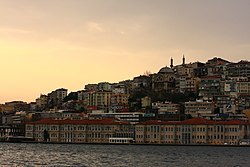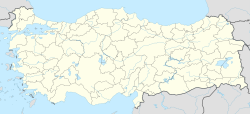world.wikisort.org - Turkey
Cihangir is a neighborhood in the Beyoğlu district of Istanbul, Turkey, between Taksim Square and Kabataş.[1] It has many narrow streets, two parks, and many street cafes especially in and around Akarsu Yokuşu Sokağı.
This article includes a list of general references, but it lacks sufficient corresponding inline citations. (December 2017) |
Cihangir | |
|---|---|
Neighborhood | |
 | |
 Cihangir Position of Cihangir | |
| Coordinates: 41°01′59″N 28°59′07″E | |
| Country | Turkey |
| Region | Istanbul |
| Subregion | Istanbul |
| Province | Istanbul |
| District | Beyoğlu |
| Government | |
| • Headman | Adnan Bal |
| Population (2016) | |
| • Total | 3,549 |
The neighbourhood has a bohemian reputation.[2] It is known for its artists, writers, actors, and expatriates - as well as large army of street cats. It was also a stronghold for protesters during the Gezi Park protests.[1]
Cihangir was named after Şehzade Cihangir whose heart-broken father, Suleiman the Magnificent, had Mimar Sinan build a mosque overlooking the Bosphorus to commemorate his death. The name means "conqueror" in Turkish and, in turn, comes from the Persian compound word jahan + gir (جهانگیر), meaning "conqueror of the world". Today, the Cihangir Mosque, originally built in 1559 but reconstructed in 1889, offers views across the Bosphorus to Sarayburnu.[2]
In 2012, the British newspaper The Guardian included Cihangir and neighbouring Çukurcuma in the list of the five best places in the world to live, next to Santa Cruz de Tenerife, in Spain; the district of Sankt Pauli, in Hamburg, the north coast of Maui, in Hawaii and Portland, in the state of Oregon (United States).[3]
Ece Temelkuran wrote that this neighbourhood is like Soho, Manhattan.[4]
Demographics
| Year | Pop. | ±% p.a. |
|---|---|---|
| 2007 | 3,641 | — |
| 2008 | 3,714 | +2.00% |
| 2009 | 3,662 | −1.40% |
| 2010 | 3,722 | +1.64% |
| 2011 | 3,774 | +1.40% |
| 2012 | 3,653 | −3.21% |
| 2013 | 3,761 | +2.96% |
| 2014 | 3,658 | −2.74% |
| 2015 | 3,742 | +2.30% |
| 2016 | 3,549 | −5.16% |
History
During Byzantine times, the area of the present neighborhood was probably not settled, although there were Byzantine buildings near present-day Tophane and Fındıklı below Cihangir.
During the reign of Suleiman the Magnificent, the area was a forested hunting ground.[6] It was one of the favourite places of Suleiman's son Cihangir after whom it is named.
In the second half of the 19th century, the increasing influx of non-Ottoman Europeans into Istanbul drove up real estate prices in the nearby Pera district in Beyoğlu, to which they were officially confined. Some Europeans, however, acquired land in areas outside Pera such as Tophane, Fındıklı, and Cihangir, leading to a great deal of upmarket residential development in those neighbourhoods.
Starting in the 1930s, non-Muslim residents of Cihangir and the rest of Beyoğlu left or were forced out. They were replaced by Muslims from other Istanbul neighbourhoods and by internal migrants from eastern Turkey. As the character of the neighbourhood changed, middle-class Muslims also began leaving it. By the 1970s, Cihangir was known as an area where Anatolian migrants lived alongside artists and intellectuals. Steady gentrification pushed up house prices in the area during the 2010s but after the inconveniences inflicted on local residents by the troubles around the Gezi Park protests of 2013, there was something of an exodus from the area. In particular, younger more bohemian people started to move across the Bosphorus to Kadıköy. Since 2020, however, the exodus has gone into reverse and house prices were once again soaring by 2021.
In the early twenty-first century, Cihangir became well-known for its cafes, artists, and bohemian culture.[1] In addition, the neighborhood is known for its street cats, and local residents help feed and take care of the cats.[7] The documentary Kedi, which profiles street cats, was largely filmed in Cihangir.[8]
References
- Delin, Sevil (2013-12-09). "A day in … Cihangir, Istanbul". The Guardian. ISSN 0261-3077. Retrieved 2019-05-23.
- "Cornucopia Magazine". www.cornucopia.net. Retrieved 2019-05-23.
- "Santa Cruz de Tenerife, uno de los cinco mejores sitios del mundo para vivir, según "The Guardian"". ABC.es. Retrieved 25 May 2015.
- Temelkuran, Ece (2019). How to Lose a Country: The Seven Steps from Democracy to Dictatorship. London: HarperCollinsPublishers. p. 131. ISBN 978-0-00-829404-5.
- Turkish Statistical Institute
- "Cornucopia Magazine : A Connoisseur's Guide to Cihangir". www.cornucopia.net. Retrieved 2020-03-02.
- Dark, Gülşah (2016-12-08). "Cihangir Cool for Cats: The unsung heroes giving hope to Istanbul's street animals". Daily Sabah. Retrieved 2020-03-03.
- Hartman, Darrell (2017-02-07). "The Alley Cats of Istanbul". The Paris Review. Retrieved 2020-03-03.
- Printed Sources
- Hürel, Haldun (2008). Semtleri, Mahalleri, Caddeleri ve Sokakları A'dan Z'ye İstanbul'un Alfabetik Öyküsü. İkarus. ISBN 978-975-999-290-3.
- İlkuçan, Altan (2004). Gentrification, Community and Consumption: Constructing, Conquering and Contesting "The Republic of Cihangir". Master's thesis, Dept. of Management, Bilkent University, Ankara. http://www.thesis.bilkent.edu.tr/0002485.pdf
- Karpat, Kemal H. (2002). Studies on Ottoman social and political history: Selected articles and essays. Brill. ISBN 9789004121010.
- Kleiss, Wolfram (1965). Topographisch-archäologischer Plan von Istanbul: Verzeichnis der Denkmäler und Fundorte. Verlag Ernst Wasmuth.
External links
| Wikimedia Commons has media related to Cihangir. |
Другой контент может иметь иную лицензию. Перед использованием материалов сайта WikiSort.org внимательно изучите правила лицензирования конкретных элементов наполнения сайта.
WikiSort.org - проект по пересортировке и дополнению контента Википедии